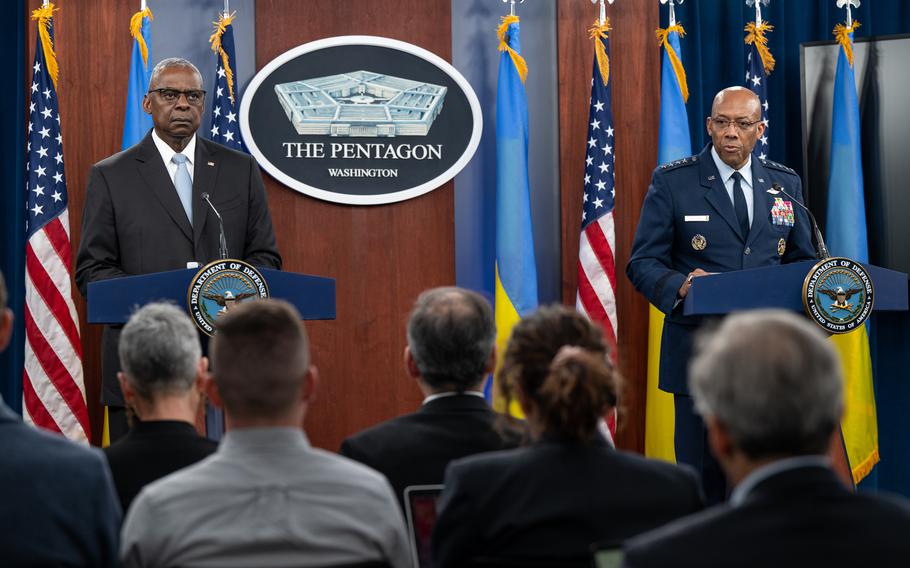
Defense Secretary Lloyd Austin, left, and Air Force Gen. Charles “CQ” Brown, chairman of the Joint Chiefs Of Staff, take part in a news briefing at the Pentagon on Monday, May 20, 2024. (Jackie Sanders/Department of Defense)
WASHINGTON — Defense Secretary Lloyd Austin said Monday that defending against aerial attacks is critical for Ukrainian forces fighting off surging Russian invaders and urged allies to come up with more air-defense weapons to send the embattled country.
“We’re meeting at a moment of challenge. [Russian President Vladimir] Putin’s invaders have launched another offensive onto sovereign Ukrainian territory,” Austin said at the start of a Ukraine Defense Contact Group meeting Monday. “And the Kremlin’s forces will try to make further advances in the weeks ahead — and try to carve out a buffer zone along the Ukrainian border.”
Russian forces, which had made only moderate advances in recent months, launched a surprise assault in the northeast region of Ukraine on May 10 that resulted in their biggest territorial gains in nearly 18 months.
“Putin is trying to wage a 19th century war of imperial aggression in the world of 2024. We spent a lot of time today on lifesaving, air-defense systems, which are helping Ukraine stave off waves of Russian missiles, Iranian [drones] and North Korean munitions,” Austin said at a Pentagon news conference following the defense group’s meeting. “We will continue to push to ensure that Ukraine owns its skies and can defend its citizens and civilian infrastructure far from the front lines.”
Air Force Gen. Charles “CQ” Brown, chairman of the Joint Chiefs of Staff, said the Pentagon is paying close attention to the fighting near Kharkiv in northeast Ukraine.
Yet no new military aid was announced Monday.
Secretary of State Antony Blinken last week announced $2 billion in aid to help Ukraine build up its defense industrial base. Blinken said during a recent two-day visit to Ukraine that the U.S. was working to get more ammunition and weapons quickly to the front lines to help Ukrainian forces fight the new Russian ground incursion into the Kharkiv region.
Ukraine President Volodymyr Zelenskyy said Friday that Ukraine only has a quarter of the air defenses that it needs to hold the front line while the war grinds on.
More so, there have been recent complaints from Ukraine regarding the U.S. policy that prevents them from firing U.S.-provided weapons into Russia. But the U.S. quietly shipped a set of long-range missiles to Ukraine in March for the first time in nearly two years. Army Tactical Missile Systems were used twice to strike deep behind Russian lines, Politico reported.
Austin and Brown on Monday avoided questions on whether Ukrainian troops should be permitted to use American weapons to fire at forces just over the border in Russia, saying their focus is on the fighting in Ukraine.
The U.S. has provided three military aid packages to Ukraine since Congress passed legislation last month approving $95 billion in foreign aid. The $95 billion includes money for Israel and Taiwan, with $60 billion for Ukraine. President Joe Biden signed the legislation, followed by the Pentagon announcing $1 billion in military aid in air-defense systems and artillery rounds.
Two days later, the Pentagon announced another $6 billion in military aid provided through the Ukraine Security Assistance Initiative, or USAI, which gives long-term assistance to procure weapons and munitions from the defense industry or partner countries for a later time. This package was the largest security assistance that the U.S. has committed to Ukraine.
“You’ll see a steady flow of U.S. assistance to Ukraine week after week,” Austin said.
The U.S. announced $400 million in military aid on May 10 that included High Mobility Artillery Rocket Systems and rockets for them, as well as munitions for Patriot and National Advanced Surface-to-Air Missile Systems, artillery, anti-aircraft and anti-tank munitions, and an array of armored vehicles.
The virtual meeting on Monday of the Ukraine Defense Contract Group, which consists of about 50 nations to provide assistance and weapons to Ukraine, is the 22nd time the group has met since forming a little more than two years ago.
Military aid from the U.S. to Ukraine was halted in December following the Pentagon’s $250 million package of weapons and equipment. The congressional aid legislation last month ended months of political deadlock that saw the bill stall because some Republicans were opposed to arming Ukraine though Russia has gained momentum on the battlefield.
During that time, the Pentagon was able to send $300 million in weapons and ammunition in March after defense officials said they were able to find cost savings in earlier Ukraine contracts and used that money to send more military aid to the country.